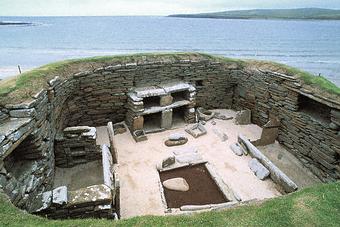| Region : | Orkney | |
|
| Island : | Mainland | ||
| Area : | Bay of Skaill | ||
| Grid Reference : | HY 231 187 | ||
| Period : | 3100-2500 BC | ||
SETTLEMENT
 |
|
One of the best preserved buildings is House 1 (in the photo), which displays some of the most evocative features of Neolithic domestic life: opposite to the entrance is a remarkable stone dresser, where prized objects were probably displayed. Around it, a grinding stone and three small tanks set into the floor: their slabs were cemented with clay to make them watertight and they were used to prepare fish bait (soaked limpets). Between the dresser and the central hearth, is a stone seat. On either side of the house are slab-built beds, with cupboards for personal belongings set into the walls. The furniture was made from local flagstone.
All the houses have recesses, compartments and cells in the walls. Some of them, such of those behind the dressers, are not easily accessible. They were mainly used as storage spaces, but some cells, with drains running underneath them, could have been toilets.
The houses, which measure from 4.3m x 4m to 6.4m x 6.1m, were probably roofed with timber, whalebone, turf and heather.
The so-called workshop lies to the west of the village. It is a free-standing structure, with a central hearth but no dresser, no stone boxes, no beds. During excavation a lot of stones fractured by heat and fragments of chert were found. These finds suggest that it was a workshop for the making of stone tools.
A large amount of organic materials and artefacts were found and helped in giving an excellent picture of life in Neolithic times: among them some carved stone objects, probably used for ritual purposes, stone axes and a lot of bone tools (points, slices, mattocks) and jewels (pins, pendants and beads).
Near the Skara Brae village is a nice small site museum, where many artefacts are displayed, and a modern reconstruction of one of the houses.
In care of Historic Scotland